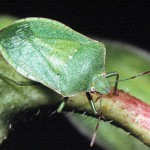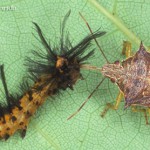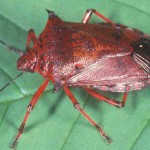Stink bugs
Soldier bugs, also known as stink bugs, are known as serious pests as well as useful predators because different species vary in their eating habits. The most common stink bug in Florida, the southern green stink bug, attacks blossoms and fruit, causing deformity and fruit drop. How can you distinguish between good and bad stink bugs? All stink bugs have long, thin, tubular piercing-sucking mouthparts. The good bugs use their mouthparts to extract fluid from other insects, particularly caterpillars and beetle grubs. The bad bugs use their mouthparts to extract plant sap. The mouthparts of good soldier bugs are relatively sturdy, whereas the mouthparts of pest species are relatively thin and frail. If in doubt, you might observe the bug’s behavior before deciding whether it is good or bad–a predaceous stink bug is a good bug.

Southern green stink bug
Alcaeorrhynchus grandis (Dallas), sometimes called the giant strong-nosed stink bug, is a very large (20 mm) predatory stink bug that occurs in several row crops and preys on other insects, especially lepidopterous larvae.

Giant strong-nosed stinkbug
The length of the adult male is 16–21 mm, with the humeral width 9–12 mm (including spines). Adult female length is 18–25 mm, while the humeral width is 11–14 mm (including spines). The adults have double spines on the humeral angles. The adults of A. grandisare variegated brown in color, with dark bands on the legs and dark maculations along the dorsolateral margins of the abdomen. They are the largest predatory stink bugs in Florida and generally resemble Podisus maculiventris (Say), from which they can be distinguished by their larger size and double, rather than single, humeral spines.

Plant feeders usually have rounded “shoulders.” Plant feeds have long, thin mouthparts tucked beneath their bodies, whereas predators have a short, stout beak they hold out in front of them. Plant-feeding stinkbugs are common pests of vegetables and fruits. (Nezara viridula). Found throughout the world, the southern green stinkbug attacks over 30 families of plants, though the preference is for legumes and crucifers. The bugs also are attracted to those crops setting pods or fruit. The bug is able to complete a lifecycle in as little as 45 days, and four to five generations are possible in a year. As insecticides are becoming more specific for certain pests, these bugs are becoming a more prominent pest in certain vegetable crops. The feeding of both immature and mature stink bugs is most prominent on young succulent tissue. After feeding, the wounded site becomes hard and darkened. Fruit may become deformed or drop from the plant. The bugs also can infect the fruit with pathogens.
True to their name, most stink bugs emit a foul odor if handled.
Contact
Wakulla County Extension Address
84 Cedar Avenue
Crawfordville, FL 32327
Hours
Monday - Friday
8:00am – 5pm
Samantha Kennedy
UF/IFAS Wakulla County Extension Director & FCS Agent
Phone (850) 926-3931
skennedy@ufl.edu

